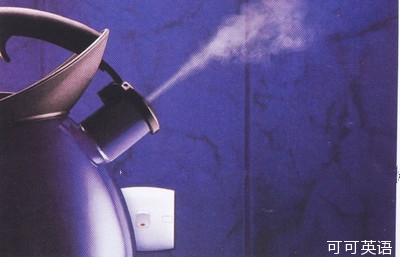British physicist Lord Rayleigh is best known for his discovery of argon and for explaining, in 1871, why the sky is blue.
英国物理学家瑞利勋爵因为1871年发现氩元素及解释而变得举世闻名。
But he also puzzled over this: sound of a kettle whistling.
但是他也一直饱受一个问题的困扰:那就是水壶沸腾时的鸣叫声。
Rayleigh knew that a kettle makes that sound when steam jets through the hole in a thick lid that has a gap in the middle.
瑞利勋爵知道水壶发出声响是由于水蒸气穿过厚厚盖子中间有空隙的孔所致。
He speculated that the jet becomes unstable inside that gap, setting up an acoustic feedback loop within the gap.
他怀疑蒸汽经过盖子孔隙时变得不稳定,是在间隙内引起了声学回路。
But he couldn't prove it.
但他一直无法证明这一猜测。
 Now two engineers at Cambridge University claim to have solved the puzzle—and proved Rayleigh wrong.
Now two engineers at Cambridge University claim to have solved the puzzle—and proved Rayleigh wrong.
而现在,剑桥大学的两名工程师宣布他们已经解决了这个难题—而且还证明瑞利勋爵的猜测是错的。
The work is in the journal Physics of Fluids.
这一研究已在《流体物理学》杂志上发表。
The engineers found that a kettle actually whistles in two distinct ways.
工程师们发现水壶发出声音有两种方式。
It starts off with air vibrating in the gap between the layers of the lid, like when you do this and this.
开始是由于空气在蒸汽和壶盖间的空隙中引起振动,就像你在这里听到的2种一样。
But as the pressure builds, vortices of steam peel off from the jet exiting the lid.
但随着压力越来越强,蒸汽的漩涡从壶盖的出口中脱离。
Each vortex creates sound waves at a frequency that depends on the length of the spout and the pressure inside it.
每个漩涡创造的特定声音波段是根据喷口的距离长度和内部当时所含的压力所定,
Rising temperature means rising pressure, which produces a rising whistle which means it's time for tea.
温度上升意味着压力上升,而与此形成的哨声是在告诉我们是享用一杯茶的时间了。
 Now two engineers at Cambridge University claim to have solved the puzzle—and proved Rayleigh wrong.
Now two engineers at Cambridge University claim to have solved the puzzle—and proved Rayleigh wrong. Now two engineers at Cambridge University claim to have solved the puzzle—and proved Rayleigh wrong.
Now two engineers at Cambridge University claim to have solved the puzzle—and proved Rayleigh wrong.